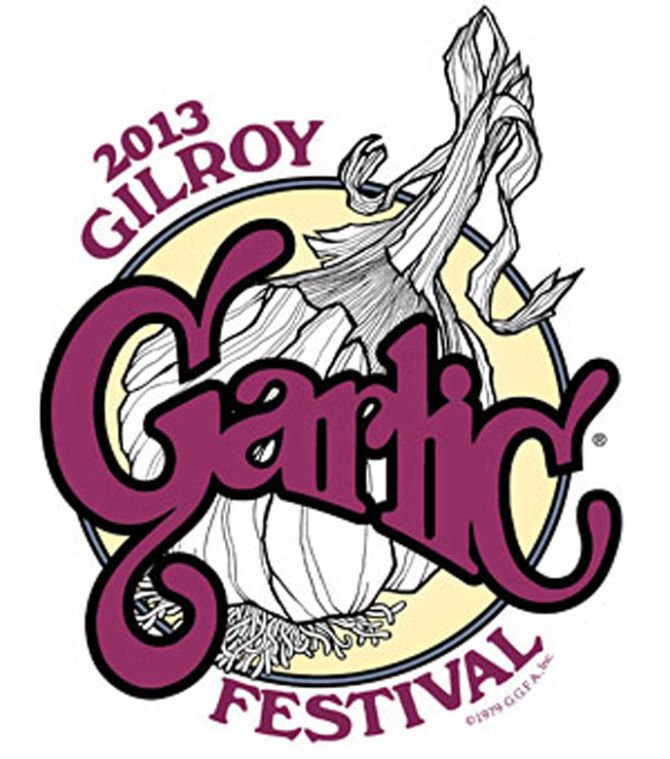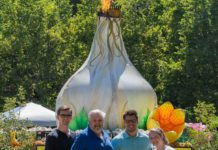Its odor hangs heavy in the air – especially on hot days – and its bulbous visage is incorporated into all manner of logos seen around the city. Next week’s festival celebrates it and local young women fight for the honor of being crowned its queen.
A medicine since the days of Hippocrates, it has also served as a talisman against evil spirits in India, a powerful ward against vampires in Central Europe and even made it into mid-16th century English culinary creations – a country not particularly noted for Epicurean extravagance.
For all of its worldly accomplishments, the humble allium sativum – better known as Garlic – has also made itself an integral part of the societal fabric – nay, the very soul – of Gilroy. Garlic is to this city what cheese steaks are to Philadelphia; what po-boys are to New Orleans; what deep dish pizza is to Chicago.
But, notwithstanding the hometown pride, can a city nestled in South Santa Clara Valley stand by its claim of being a “Garlic Capital” in the face of stiff competition from China and beyond?
Mayor Don Gage says it can.
“We produce quality California garlic and California garlic is one of the best,” he reasoned.
The truly international nature of the Garlic Festival (in its 35th year and taking place July 26 – 28 at Christmas Hill Park) in its ability to bring gastronomes from around the globe in search of garlicky nirvana, is proof enough of Gilroy’s “capital” status, explained Gage.
In recent years, Gilroy has shortened its tagline moniker from “Garlic Capital of the World” to simply “Garlic Capital” to reflect more accurately its place in the garlic universe. It may not produce the most garlic by the pound, but when it comes to quality, history, culture, garlic-themed products, events, businesses and the fact the city’s identity is centered around the stinking rose, locals say Gilroy takes the cake in garlic spirit.
“We pride ourselves that we are part of that claim,” maintains Brian Oteri, owner of Garlic World at 4800 Monterey Road, just south of the city on U.S. 101. “We do the best we can.”
With 12 years of garlic-based business experience under his belt, Oteri thinks that this season might be one of the best ever.
“The garlic is excellent,” he said. “I’ve not seen it like this for four or five years.”
And he’s not imagining things: Numbers recently released by the Santa Clara County Crop report show garlic resurgent in the area with a total crop value of $2 million, pushing Gilroy’s favorite herb into the top 25 most valuable crops for the area.
Oteri sources all of his garlic from Christopher Ranch, which has been growing all of its garlic – including the two tons donated annually to the Gilroy Garlic Festival – on local farms for nearly 60 years. Christopher Ranch’s famed Monviso variety of garlic is the only commercially grown heirloom garlic in the United States, according to the Christopher Ranch website.
That sort of love and care – the Christopher family has never sold the Monviso seed to other farmers or planted higher yielding but blander varieties – ensures the flavor and taste that so captivated Bill Christopher’s father, Don, remains Christopher Ranch’s calling card in the garlic world. That makes choosing Gilroy’s garlic a no-brainer, Bill says.
“There’s much more flavor in ours,” he said. “The ground is just perfect to grow.”
According to the United States Department of Agriculture, China is the big boy on the block, taking an almost 80 percent share of the production market. But that doesn’t worry Bill, who underscores the 100 million pounds of garlic from around the world processed annually in Gilroy.
In fact, many Chinese come to Gilroy to sample the capital’s superior tasting bulbous treasure, according to Bryce Nielsen, an employee of the Garlic Shoppe located on San Ysidro Avenue at the Gilroy Outlets.
The Garlic Capital wouldn’t be the Garlic Capital without a plethora of stores and roadside stands beckoning tourists with stinking rose novelties ranging from garlic bleu cheese butter to garlic stuffed olives to garlic wine to garlic ice cream. If anyone knows a thing or two about capitalizing on the gourmet greatness of garlic and bottling it up for people to sell, it’s the Larson brothers.
Owned by brothers Alex and Charlie Larson, the Garlic Shoppe is a wonderland for those obsessed with all things, well, garlic. The brothers create a multitude of products under the name of Mama Rap’s, Garlic Dude and Psycho Garlicky Hot Sauce to name a few.
Standing in among all sorts of garlicky accoutrements ranging from terra cotta garlic bakers to bejeweled cooking aprons, Nielsen says that people want to make sure their stinking rose comes from Gilroy.
“They’ll pay the extra,” he noted.
A Gilroyan through and through, it seems logical that a man with a lifelong passion for garlic should end up working in a store filled to the brim with the stuff.
“When I was a kid, pickled garlic was like a candy to me,” he laughed. “It still is I suppose.”
Nielsen’s palate is so attuned to the herb that its absence from a meal has his taste buds wanting.
“I wonder what’s missing,” Nielsen said. “Then I go and add some garlic of my own.”
But this Epicurean idyll enjoyed by locals didn’t happen overnight. After a spell as the tobacco capital of the world during the 1870s – when Gilroy was reportedly rolling over a million cigars at a local factory – Gilroy went down the dairying and cheese-making route following an influx of Swiss and middle-Europeans.
The moniker of “Dairy and Cheese Capital of California” rested on Gilroy’s shoulders for a decade until the arrival of the French prune in the 1890s, according to the City’s website.
By the 1920s, much of Gilroy’s lush agricultural land had been given over to orchard crops such as apples, cherries and of course, prunes. Naturally, capitalizing on what it was known for, Gilroy rechristened itself the Prune Capital of California. It was only a matter of time, it seems, before Gilroy would once again look for another agricultural title to hang around its neck.
Although garlic was already being grown in Gilroy, it was the arrival of Japanese farmers after WWI that caused the switch to large-scale, commercial garlic growing.
The most prominent of the growers was Kiyoshi Hirasaki who started Hirasaki Farms Inc., according to documents supplied by the Gilroy Museum. In 1941, Kiyoshi had 1,500 acres planted in garlic, the largest producer at that time and by 1948 had built a warehouse at 10th and Alexander streets. Eight years later, Don Christopher arrived in South Santa Clara Valley and began his love affair with the stinking rose. Fate or not for Gilroy, Don was much more succinct about the driving force behind his relocation in a 1995 interview featured in the Smithsonian magazine.
“I came from a prune ranch,” he noted. “I really hated growing prunes.”














